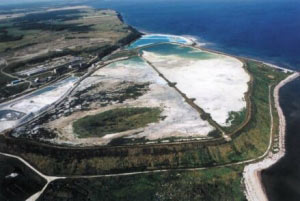Projects
- AS Sillamäe Sadam – environmental management, waste management (reception bilge waters and an oil waste from ships), environmental monitoring;
- OÜ NPM Silmet – environmental management, waste management, monitoring of working conditions and natural environment;
- AS Silpower – environmental management, waste management, monitoring of working conditions and natural environment;
- AS Ecometal – preparation and procurement of the integrated environmental permit, waste management, monitoring of working conditions and natural environment;
- AS SilSteve – environmental management and monitoring;
- AS DBT – environmental monitoring;
- Puma Energy Baltics AS Sillamäe Terminal – environmental monitoring;
- Orica Eesti OÜ – environmental monitoring;
- Close-down of the ash field No 2 and settling ponds at the Baltic Power Station – project management and construction supervision;
- Sillamäe Radioactive Tailings Pond Remediation (closure) was carried out in the period 1997 – 2008; From 2009 to the present Ökosil Ltd performs control and monitoring of closed waste storage.
The radioactive tailing pond in Sillamäe is located in the Ida-Viru county, in the western part of Sillamäe, directly on the coast of the Gulf of Finland. The depository is located on a territory of approximately 40 hectares and contains about 12 million tons of uranium process tailings and oil shale ashes, deposited there since the secrete uranium production factory of the Soviet Union was established in 1948.

The construction of the depository started in the fifties. At first, it was intended to surround the depository by a 12-meter high dam (dyke); by now the absolute height of the embankment is 24,5…. 25,5 meters. The embankments are filled with gravel and pit sand, ashes from the depository, , construction and tailings.

The tailings
Poisonous and dangerous refuse – greyish brown slurry, containing uranium and heavy metals, acids and other chemicals – remains from the processing of the uranium ore, both dictyonema shale and up to 100 times richer ore, later imported from the Eastern countries.
12 million tons of these substances – uranium refuse mixed with oil-shale ashes make up the “Uranium Lake” of Sillamäe.
During years and decades the substance consolidates and changes into a clay-like (clayish) mass. In Sillamäe, it has happened partially: there are places where one can walk on the surface lake and places where a stone, thrown there disappears immediately.

Sillamäe depository is located immediately by the sea. The seaside dam is not farther than 30 to 50 meters from the waterfront.
Environment hazards
Research has proved that there exist both hazards: direct – constantly spreading pollution – and indirect – the seaside dam of the depository is instable and may break.
The pollution spreads from the depository in three different ways:
- Rain and water pouring from the mainland from time to time slowly seep through the mass of tailings and carry dangerous substances (uranium, thorium, barium, strontium, arsenic) to the sea;
- In the summer almost the whole surface of the depository is dry and wind carries dust form the depository to the surroundings and residential areas of Sillamäe, which are located approximately 1,5 to 2 km from the depository;
- The depository emanates radioactive gas – radon – which partially spreads over the town as well.
In case the seaside embankment breaks, incalculable quantity of dangerous substances may flow into the sea.

